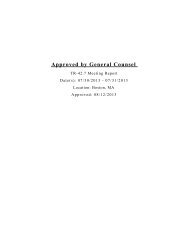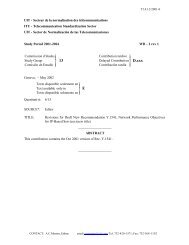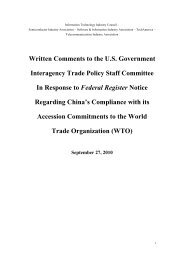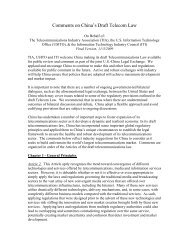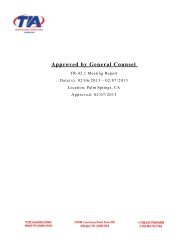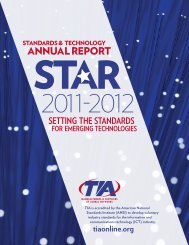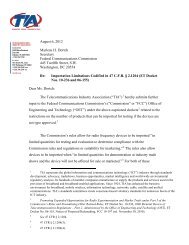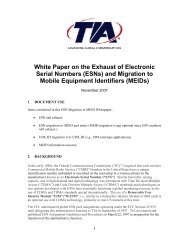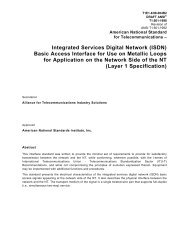ITU-T V.150.1
ITU-T V.150.1
ITU-T V.150.1
- No tags were found...
You also want an ePaper? Increase the reach of your titles
YUMPU automatically turns print PDFs into web optimized ePapers that Google loves.
12.3.4.1 Low-speed Error Controlled link to Low-speed non-error Controlled link<br />
For this example, there are also two conditions to consider. Although the modulations selected for<br />
the links are considered low-speed, there may still be mismatched data signalling rates. For example<br />
V.22 bis to V.21, which would give 2400 bit/s on one of the links and 300 bit/s on the other. The<br />
symmetric case could also occur.<br />
12.3.4.1.1 Error controlled has higher rate<br />
Since the link with the higher rate is error controlled, its effective data signalling rate being input to<br />
the IP network can be less than the rate at which it is being delivered from the peer Gateway to its<br />
local modem. This meets the Rate Match ule defined in clause 12.3.2.1.1.<br />
12.3.4.1.2 Non-Error controlled has higher rate<br />
In this type of connection the Rate Match Rule for the error controlled to non-error controlled<br />
transmit path is established, so there are no issues with data over-run. However, in the non-error<br />
controlled to error controlled transmission path, the data signalling rate from the G2/M2 link is<br />
higher than that of the M1/G1 link. It will require appropriate buffering of data to minimize data<br />
loss due to over-running of data.<br />
12.3.4.2 High-speed error controlled link to low-speed non-error controlled link<br />
This connection type is similar to that described in clause 12.3.4.1.1. The ability for the high-speed<br />
modulated link to modify its data-signalling rate such that it meets the Rate Match Rule is an<br />
advantage for this case.<br />
12.3.4.3 Low-speed error controlled link to high-speed non-error controlled link<br />
This connection type is similar to that described in clause 12.3.4.1.2. The data signalling rate from<br />
the error controlled link is less than that of the non-error controlled link. In the opposite direction, it<br />
is possible for the rate from non-error controlled link to exceed the ability of the error-controlled<br />
link to receive it without over-running.<br />
Since the non-error controlled link has the ability to modify its data-signalling rate to meet the Rate<br />
Match Rule then loss of data can be mitigated. In the case where the Rate Match Rule cannot be<br />
met additional buffering may help, but loss of data may still occur.<br />
12.3.4.4 High-speed error controlled link to high-speed non-error controlled link<br />
For this connection type, both links have the ability to modify their data-signalling rate. Applying<br />
the Rate Match Rule to adjust the effective data signalling rates of the two PSTN links will mitigate<br />
any potential data loss due to over-run.<br />
12.4 Break Handling<br />
This section introduces how a MoIP Gateway supports the transport of break signals that are<br />
generated by an end-point DCE. Also described are the methods used to handle the break<br />
acknowledgement signal when it is applicable. Clauses 15.4.6 and 15.4.7 define the message<br />
formats and clause 22.1.1 define the procedures.<br />
The following error-correcting scenarios (as defined in clause 12.1) are all considered: error<br />
corrected; symmetrical non-error corrected and asymmetrical non-error corrected.<br />
Every unique (non-repeated) break signal generated by a local end-point DCE shall be relayed to<br />
the remote end-point DCE. Repeated break signals shall not be relayed to the end-point DCE. For<br />
the case where the error control protocols are different or not present on each end of the connection,<br />
<strong>ITU</strong>-T Rec. <strong>V.150.1</strong> (01/2003) – Prepublished version 18



